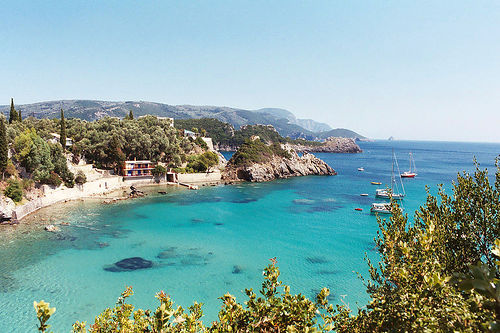

Location: Ionian Islands Map
Then you travel to Corfu Island don’t forget that its second Greek name is actually Kerkira. Greek name of Corfu Island comes from a daughter of river god Asopos. Corfu is an Italian version of Greek koryphai, which means the “hills”. Corfu Island changed hands several times and you will see here reminders of Greek, Roman, Byzantine, Venetian, Ottoman and British rule in architecture, ruins and lifestyles of its inhabitants. The easiest way to get to Corfu Island is taking a bus to the island from Athens. A ferry will take across narrow stretch of water that divides the island from mainland Greece.
Esplanade is a city town square and park. Cricket field by British, firing range by Venetians.
Palace of Saint Michael and Saint John stands on the northern end of Esplanade. Build between 1819 and 1824 this was build for British High Commissioner and renovated in the 1950’s. Today it houses tourist center, library and administrative buildings.
Museum of the Asiatic art is part of the palace of St. Michael and St. John. This rich collection houses over 10,000 items. It is closest on Mondays. For more information you can call (26610)30443.
Liston is located on the Western side of the square this is made of several stores and restaurants. It looks French since it is build by orders of Napoleon who wanted to copy restaurants of rue de Rivoli in Paris.
Enosis
monument- also known as Unification monument marks unification of the
Archaelogical museum- Odos Vraila 5, tel: (26610)30680 closed Monday
Ionian Bank, Plateia Iroon Kypriakou, tel: (26610) 41552
closed sun
Byzantine museum is located in the church of the Panagia, tel: (26610) 38313 closed Monday
The Old Fortress was completed in 1559 by Venetians on the ruins of the 7th century fortress.
The Old Hospital is located just outside of the Old Fortress. It is abandoned now, but fairly easy to access, although don't expect much help from the locals. They might show you general direction, but many avoid the place due to some alleged paranormal activity.
The New Fortress was constructed by Venetians in 1576 with several minor reconstruction until 17th century. Besides thick walls this citadel has a network of chambers, galleries and passageways for better mobility under enemy fire.
Achilleion Palace is located just 10 km south of Corfu near municipality of Gastouri lies a small town by the name of Achilleion. Its main attraction is it palace build in 1890 by Empress of Austria Elizabeth of Bavaria (aka Sissi). She build this palace a year after suicide of her son along with his mistress. Empress chocked by her loss build her residence around mythological Greek hero Achilles who died in Troy siege leaving behind his grieving mother. This motif is visible in many parts of the building. During WWI it housed a hospital for French and Serbian troops and in the WWII it housed Axis headquarters. Now it is a state property and devoted to tourism.
Ancient Greece
Mythology
Evidence
of human presence in Corfu can be found from the Paleolithic era but
also from the Neolithic era, relics have been found in various
areas. The oldest reference to Corfu is recorded in the Mycenaean
period around 1300 BC. with the Greek word "ko-ro-ku-ra-i-jo" in
Linear B which translates as "man from Corfu". According to Strabo,
Corcyra was the Homeric island of Scheria and the inhabitants of the
island were known as Faiakes. The island has really been identified
by many historians after the 6th century BC. with the "Island of the
Phaeacians" described in Homer's Odyssey although other historians
identify it with Ithaca. The Greek Lesbian reports that Poseidon
fell madly in love with the nymph Corfu or Corcyra, daughter of the
river Asopos, abducted her from her home in Ancient Boeotia and
brought her to the island where the fruit of their relationship
Faiakas was born. The island was also named "Scheria" because the
Goddess Demeter asked Poseidon to stop (almost) the alluvium of the
opposite river, so as not to unite the island with the opposite
shore-, Faiakia, Korkyra (Doric type), Corfu. The name Corfu seems
to be of Illyrian origin, perhaps it also comes from the word
"Corfu" (name of a light type of ship, or a fish).